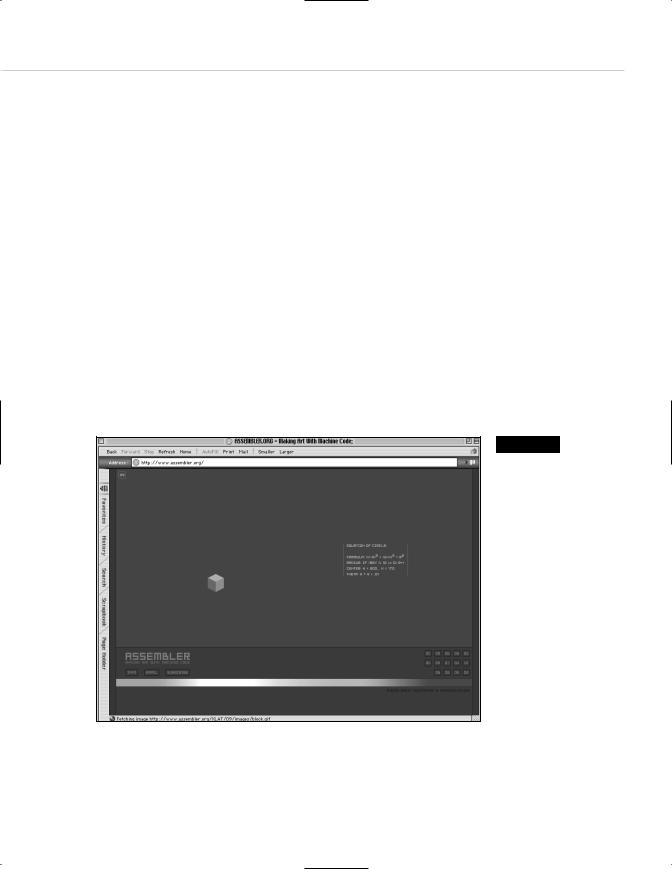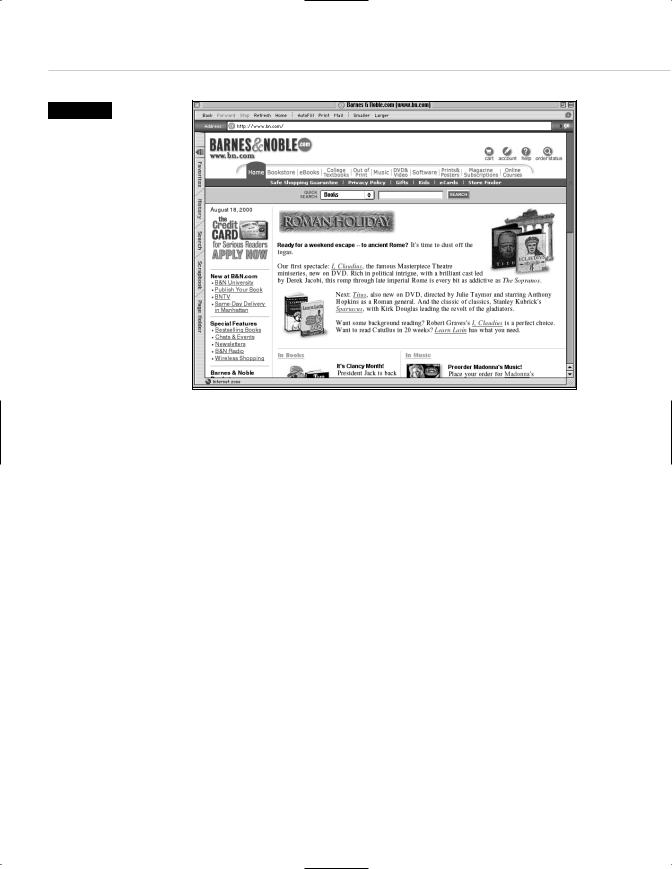
- •Taking Your Talent to the Web
- •Introduction
- •1 Splash Screen
- •Meet the Medium
- •Expanding Horizons
- •Working the Net…Without a Net
- •Smash Your Altars
- •Breath Mint? Or Candy Mint?
- •Where’s the Map?
- •Mars and Venus
- •Web Physics: Action and Interaction
- •Different Purposes, Different Methodologies
- •Web Agnosticism
- •Point #1: The Web Is Platform-Agnostic
- •Point #2: The Web Is Device-Independent
- •The 18-Month Pregnancy
- •Chocolatey Web Goodness
- •’Tis a Gift to Be Simple
- •Democracy, What a Concept
- •Instant Karma
- •The Whole World in Your Hands
- •Just Do It: The Web as Human Activity
- •The Viewer Rules
- •Multimedia: All Talking! All Dancing!
- •The Server Knows
- •It’s the Bandwidth, Stupid
- •Web Pages Have No Secrets
- •The Web Is for Everyone!
- •Swap text and code for images
- •Prune redundancy
- •Cache as Cache Can
- •Much Ado About 5K
- •Screening Room
- •Liquid Design
- •Color My Web
- •Thousands Weep
- •Gamma Gamma Hey!
- •Typography
- •The 97% Solution
- •Points of Distinction
- •Year 2000—Browsers to the Rescue
- •Touch Factor
- •Appropriate Graphic Design
- •User Knowledge
- •What Color Is Your Concept?
- •Business as (Cruel and) Usual
- •The Rise of the Interface Department
- •Form and Function
- •Copycats and Pseudo-Scientists
- •Chaos and Clarity
- •A Design Koan: Interfaces Are a Means too Often Mistaken for an End
- •Universal Body Copy and Other Fictions
- •Interface as Architecture
- •Ten (Okay, Three) Points of Light
- •Be Easily Learned
- •Remain Consistent
- •Continually Provide Feedback
- •GUI, GUI, Chewy, Chewy
- •It’s the Browser, Stupid
- •Clarity Begins at Home (Page)
- •I Think Icon, I Think Icon
- •Structural Labels: Folding the Director’s Chair
- •The Soul of Brevity
- •Hypertext or Hapless Text
- •Scrolling and Clicking Along
- •Stock Options (Providing Alternatives)
- •The So-Called Rule of Five
- •Highlights and Breadcrumbs
- •Consistent Placement
- •Brand That Sucker!
- •Why We Mentioned These Things
- •The year web standards broke, 1
- •The year web standards broke, 2
- •The year web standards broke, 3
- •The year the bubble burst
- •5 The Obligatory Glossary
- •Web Lingo
- •Extranet
- •HTML
- •Hypertext, hyperlinks, and links
- •Internet
- •Intranet
- •JavaScript, ECMAScript, CSS, XML, XHTML, DOM
- •Web page
- •Website
- •Additional terminology
- •Web developer/programmer
- •Project manager
- •Systems administrator (sysadmin) and network administrator (netadmin)
- •Web technician
- •Your Role in the Web
- •Look and feel
- •Business-to-business
- •Business-to-consumer
- •Solve Communication Problems
- •Brand identity
- •Restrictions of the Medium
- •Technology
- •Works with team members
- •Visually and emotionally engaging
- •Easy to navigate
- •Compatible with visitors’ needs
- •Accessible to a wide variety of web browsers and other devices
- •Can You Handle It?
- •What Is the Life Cycle?
- •Why Have a Method?
- •We Never Forget a Phase
- •Analysis (or “Talking to the Client”)
- •The early phase
- •Design
- •Brainstorm and problem solve
- •Translate needs into solutions
- •Sell ideas to the client
- •Identify color comps
- •Create color comps/proof of concept
- •Present color comps and proof of concept
- •Receive design approval
- •Development
- •Create all color comps
- •Communicate functionality
- •Work with templates
- •Design for easy maintenance
- •Testing
- •Deployment
- •The updating game
- •Create and provide documentation and style guides
- •Provide client training
- •Learn about your client’s methods
- •Work the Process
- •Code Wars
- •Table Talk
- •XHTML Marks the Spot
- •Minding Your <p>’s and q’s
- •Looking Ahead
- •Getting Started
- •View Source
- •A Netscape Bonus
- •The Mother of All View Source Tricks
- •Doin’ it in Netscape
- •Doin’ it in Internet Explorer
- •Absolutely Speaking, It’s All Relative
- •What Is Good Markup?
- •What Is Sensible Markup?
- •HTML as a Design Tool
- •The Frames of Hazard
- •Please Frame Safely
- •Framing Your Art
- •<META> <META> Hiney Ho!
- •Search Me
- •Take a (Re)Load Off
- •WYSIWYG, My Aunt Moira’s Left Foot
- •Code of Dishonor
- •WYS Is Not Necessarily WYG
- •Publish That Sucker!
- •HTMHell
- •9 Visual Tools
- •Photoshop Basics: An Overview
- •Comp Preparation
- •Dealing with Color Palettes
- •Exporting to Web-Friendly Formats
- •Gamma Compensation
- •Preparing Typography
- •Slicing and Dicing
- •Rollovers (Image Swapping)
- •GIF Animation
- •Create Seamless Background Patterns (Tiles)
- •Color My Web: Romancing the Cube
- •Dither Me This
- •Death of the Web-Safe Color Palette?
- •A Hex on Both Your Houses
- •Was Blind, but Now I See
- •From Theory to Practice
- •Format This: GIFs, JPEGs, and Such
- •Loves logos, typography, and long walks in the woods
- •GIFs in Photoshop
- •JPEG, the Other White Meat
- •Optimizing GIFs and JPEGs
- •Expanding on Compression
- •Make your JPEGS smaller
- •Combining sharp and blurry
- •Animated GIFs
- •Creating Animations in ImageReady
- •Typography
- •The ABCs of Web Type
- •Anti-Aliasing
- •Specifying Anti-Aliasing for Type
- •General tips
- •General Hints on Type
- •The Sans of Time
- •Space Patrol
- •Lest We Fail to Repeat Ourselves
- •Accessibility, Thy Name Is Text
- •Slicing and Dicing
- •Thinking Semantically
- •Tag Soup and Crackers
- •CSS to the Rescue…Sort of
- •Separation of Style from Content
- •CSS Advantages: Short Term
- •CSS Advantages: Long Term
- •Compatibility Problems: An Overview
- •Working with Style Sheets
- •Types of Style Sheets
- •External style sheets
- •Embedding a style sheet
- •Adding styles inline
- •Fear of Style Sheets: CSS and Layout
- •Fear of Style Sheets: CSS and Typography
- •Promise and performance
- •Font Size Challenges
- •Points of contention
- •Point of no return: browsers of the year 2000
- •Absolute size keywords
- •Relative keywords
- •Length units
- •Percentage units
- •Looking Forward
- •11 The Joy of JavaScript
- •What Is This Thing Called JavaScript?
- •The Web Before JavaScript
- •JavaScript, Yesterday and Today
- •Sounds Great, but I’m an Artist. Do I Really Have to Learn This Stuff?
- •Educating Rita About JavaScript
- •Don’t Panic!
- •JavaScript Basics for Web Designers
- •The Dreaded Text Rollover
- •The Event Handler Horizon
- •Status Quo
- •A Cautionary Note
- •Kids, Try This at Home
- •The Not-So-Fine Print
- •The Ever-Popular Image Rollover
- •A Rollover Script from Project Cool
- •Windows on the World
- •Get Your <HEAD> Together
- •Avoiding the Heartbreak of Linkitis
- •Browser Compensation
- •JavaScript to the Rescue!
- •Location, location, location
- •Watching the Detection
- •Going Global with JavaScript
- •Learning More
- •12 Beyond Text/Pictures
- •You Can Never Be Too Rich Media
- •Server-Side Stuff
- •Where were you in ‘82?
- •Indiana Jones and the template of doom
- •Serving the project
- •Doing More
- •Mini-Case Study: Waferbaby.com
- •Any Size Kid Can Play
- •Take a Walk on the Server Side
- •Are You Being Served?
- •Advantages of SSI
- •Disadvantages of SSI
- •Cookin’ with Java
- •Ghost in the Virtual Machine
- •Java Woes
- •Java Woes: The Politically Correct Version
- •Java Joys
- •Rich Media: Exploding the “Page”
- •Virtual Reality Modeling Language (VRML)
- •SVG and SMIL
- •SMIL (through your fear and sorrow)
- •Romancing the logo
- •Sounds dandy, but will it work?
- •Promises, Promises
- •Turn on, Tune in, Plug-in
- •A Hideous Breach of Reality
- •The ubiquity of plug-ins
- •The Impossible Lightness of Plug-ins
- •Plug-ins Most Likely to Succeed
- •Making It Work: Providing Options
- •The “Automagic Redirect”
- •The iron-plated sound console from Hell
- •The Trouble with Plug-ins
- •If Plug-ins Run Free
- •Parting Sermon
- •13 Never Can Say Goodbye
- •Separation Anxiety
- •A List Apart
- •Astounding Websites
- •The Babble List
- •Dreamless
- •Evolt
- •Redcricket
- •Webdesign-l
- •When All Else Fails
- •Design, Programming, Content
- •The Big Kahunas
- •Beauty and Inspiration
- •Index

20 WHY: Designing for the Medium: Web Physics
Mars and Venus
Adept web designers take care to follow some familiar contextual conventions while breaking or reinventing others. On one site you might use CSS to turn off link underlining; on another, you preserve link underlining because the site is intended for neophyte users who need to be led by the hand. One site requires idiot-proof icons with text labels; another cries out for subtle, dynamic navigational menus. Usability People lecture sternly about the “sins” of web design, but designers don’t sin—they make decisions. A good web designer may break as many rules as she follows. Visitors determine whether the site succeeds as a piece of communication or is merely a failed, cryptic experiment. This book explores issues of navigation and interface in Chapter 3, “Where Am I? Navigation & Interface.” You’ll be exploring them for the rest of your career.
That we devote an entire chapter to navigation and interface should be indication enough that graphic design alone does not equal web design— a point we’ll restate several times in case some of you haven’t had your coffee yet. Choosing and setting type, crafting pretty buttons, and developing a grid are all well and good but not good enough. Above all, web designers are the architects of user experience.
You might feel that your training and experience have not prepared you to build such architecture, but you’ll soon see that it’s the web equivalent of what a designer always does: guide viewers toward an understanding.
WEB PHYSICS: ACTION AND INTERACTION
Design for the Web is different. It’s different because web pages don’t just sit there; they do things. More importantly, they allow visitors to do things. Magazine pages may be beautiful (or not) but the reader’s interactivity consists of reading the page (or not), dog-earing it (or not), and rereading it (or not). At most, the reader might cut it out and mail it to a friend. Strictly speaking, none of this can truly be called interactivity. Beautiful magazine layouts do not change in response to the viewer’s actions. Newspaper ads do not sprout additional body copy if the reader shows genuine interest. The Web invites depth of exploration in ways traditional media cannot. For a designer, the creative possibilities are tantalizing and practically limitless.

Taking Your Talent to the Web |
21 |
On the Web, linear motion gives way to user emotion. Site visitors link randomly as they choose. Set up as many careful hierarchies and navigational cues as you want; visitors will still do what they like on most sites. Not only may visitors move up, down, and sideways, they also can bookmark any page they fancy; download it to their hard drives; save the images from it; and even study the HTML markup with which it was produced.
Readers can order books on the Web by typing in HTML form fields supported by scripts written in Perl, Java, or other programming languages (www.amazon.com). They can post their opinions to message boards (www.metafilter.com). If the designer has given them the option, they may change the background colors to suit their mood (www.camworld.com). On fancy Dynamic HTML (DHTML) sites, they can drag images from place to place (www.dhtml-guis.com/game/). On fancier ones, they can do much more (www.assembler.org). On a corporate intranet site, employees may spend hours updating a group calendar or adding phone numbers to a contact database. (Anything to avoid working.)
Figure 2.3
Non-commercial interactivity: Assembler.org was created with DHTML (here it is done well). As of this writing, the site was optimized for Netscape and Microsoft’s 4.0 browsers, which rely on proprietary coding techniques. Thus the site’s marvels would be invisible to users of recent browsers that avoid proprietary, old-school DHTML. By the time you buy this book, the site should function well in standards-compliant browsers such as Netscape 6 (www.assembler.org).

22 WHY: Designing for the Medium: Web Physics
Figure 2.4
Commercial interactivity: Barnes & Noble, a functional and attractive shopping site. Successful e-commerce sites work in as many browsers as possible and add value to the commercial transaction by providing content and artificially intelligent “shopping tips.” Though Barnes & Noble has a real-world heritage, Amazon.com dominates the online market because Amazon came first. When web brands are effective, users can be incredibly loyal (www.bn.com).
There is obvious commercial value to commercial interactivity; novelty or
“proof of concept” value to dynamic artwork and games; branding value to interactive multimedia (www.barneys.com); and hidden value to still other types of interactivity. (Changing the background color may seem trivial to you or me, but it could be vitally important for a color-blind web user.) Overall, interactivity is a defining characteristic of the Web and thus of web design. Lesbian poetry and physics papers did not drive the rapid expansion of the medium. Commerce did that, and commerce depends on interactivity: the visitor clicks, the sale is made.
No offense to the lesbian poetry sites. In fact, no offense to the hundreds of thousands of noncommercial sites that bring richness, depth, and meaning to the Web. Without these noncommercial sites, the medium would be nothing more than a dialup variation on the infomercial. But without all the commercial sites, the Web’s infrastructure, services, and rate of adoption might never have grown so quickly.
At least, that’s what the marketers tell us. Consider this another Mars/Venus variation for your pleasure. The Internet grew in popularity for at least two years before any commercial sites were allowed on the Net,
